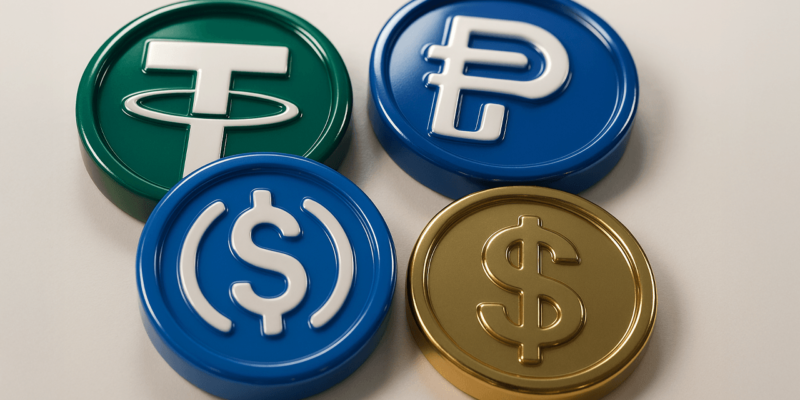The passage of the GENIUS Act in the U.S. this July marked a turning point for stablecoins, triggering renewed demand and signaling a shift toward more regulated digital asset infrastructure. That single move injected over $4 billion into the ecosystem,m and lifted wallet activity. Clearly the U.S. is finally laying the rails for regulated digital finance.
Meanwhile, Bitcoin kept slipping quietly off exchanges, a slow-motion liquidity crunch that could be setting up future volatility. In the background, a new class of digital assets, tokenized real-world assets (RWAs) continued to gain ground, while regulators across the globe ramped up activity. Speculation isn’t gone, but infrastructure is now driving the conversation.
Stablecoins Surge After U.S. Passes GENIUS Act
On July 18, U.S. President Donald Trump signed the GENIUS Act into law, offering long-awaited clarity for fiat-backed stablecoins. The legislation sets federal standards around reserves, redemption, and disclosures, giving issuers like Circle and Paxos a firmer legal footing. The market responded immediately. Stablecoins added over $4 billion in net inflows, pushing total supply above $250 billion. Monthly active wallets jumped 20% to 38 million, while transaction volumes earlier in the year had already surpassed $7 trillion.
Analysts see this as a critical moment for the stablecoin sector. The legislation validates stablecoins as part of the financial system’s infrastructure, even though it stops short of authorizing interest-bearing stablecoins. This outcome reinforces the view that regulatory clarity, rather than yield, is the key to broader adoption.
While headlines fixated on legislation, Bitcoin quietly made its own move. BTC reserves on centralized exchanges dropped another 2% in July, continuing a slow bleed that’s seen a 14% decline in listed reserves this year alone. Only 15% of Bitcoin’s total supply is now held on exchanges, the lowest since 2018.
Why it matters: shrinking exchange balances often signal long-term holding behavior and growing self-custody. OTC desks typically used by institutional players are also seeing reduced balances, hinting at lower available liquidity across the board.
Depending on who you ask, this could mean two things:
Caution: investors are waiting for a clearer catalyst
Tightening: a setup for future price volatility
Either way, liquidity is becoming scarcer.
Tokenized Real-World Assets Pass $25 Billion
The market for tokenized real-world assets (RWAs) continued to expand in July, reaching over $25 billion in total value. Most of the growth came from tokenized U.S. Treasuries and private credit products, which remain the most widely adopted RWA instruments. Tokenized equities, although still a small portion of the market, saw modest gains. Robinhood’s launch of a pilot for equity-backed tokens contributed to a 15% increase in market cap and a 700% rise in active wallets within that segment.
Still, all’s not smooth. Some equity-like tokens are coming under scrutiny for lacking basic investor rights, no voting power, no ownership guarantees, prompting regulators in the U.S. and EU to take a closer look.
Global Regulation Advances at State and International Levels
While federal developments in the U.S. attracted most attention, regulatory progress also spread through U.S. states and international borders.
In the U.S.
Missouri formally recognized gold- and silver-backed digital tokens as legal tender
New Hampshire established a commission to study stablecoins and digital asset frameworks
Oregon introduced rules treating unclaimed crypto assets as abandoned property after three years
Outside the U.S., several countries advanced crypto regulation:
Germany approved AllUnity, a euro-backed stablecoin created by Deutsche Bank and DWS
Hong Kong finalized its stablecoin guidelines and launched a public issuer registry
Under the EU’s MiCA framework, firms like Bybit, OKX, and CoinShares received operating licenses in Austria and France
Meanwhile, U.S.-based companies Circle and Ripple filed applications to become national trust banks. If approved, the licenses would enable them to issue stablecoins and offer crypto custody services under federal oversight.
Focus Shifts Toward Market Infrastructure
From stablecoins to tokenized debt instruments, the direction of digital assets appears to be shifting toward long-term infrastructure. The GENIUS Act isn’t a magic bullet. Paired with frameworks like MiCA in Europe, however, it reflects a broader shift, one that’s less about chasing yield and more about building the rails for digital finance’s next phase.
Price will always matter. Still, focusing only on charts risks missing the bigger picture: who’s building, who’s regulating, and who’s quietly preparing for what comes next.

Comments